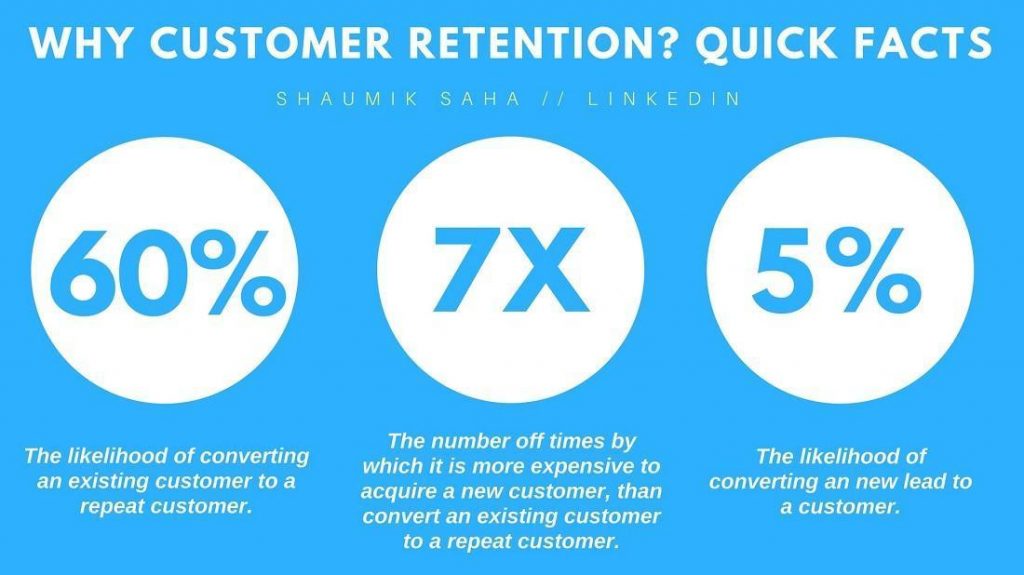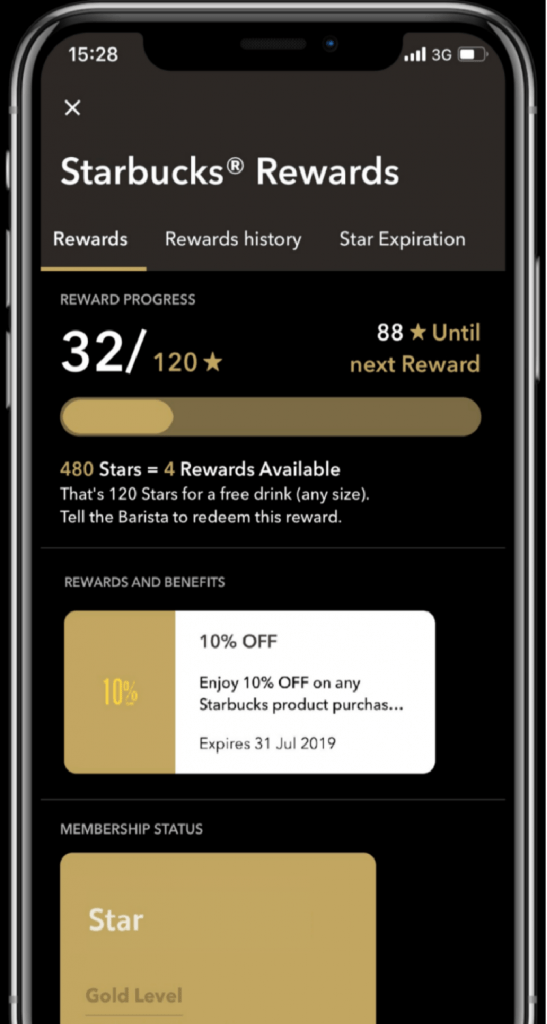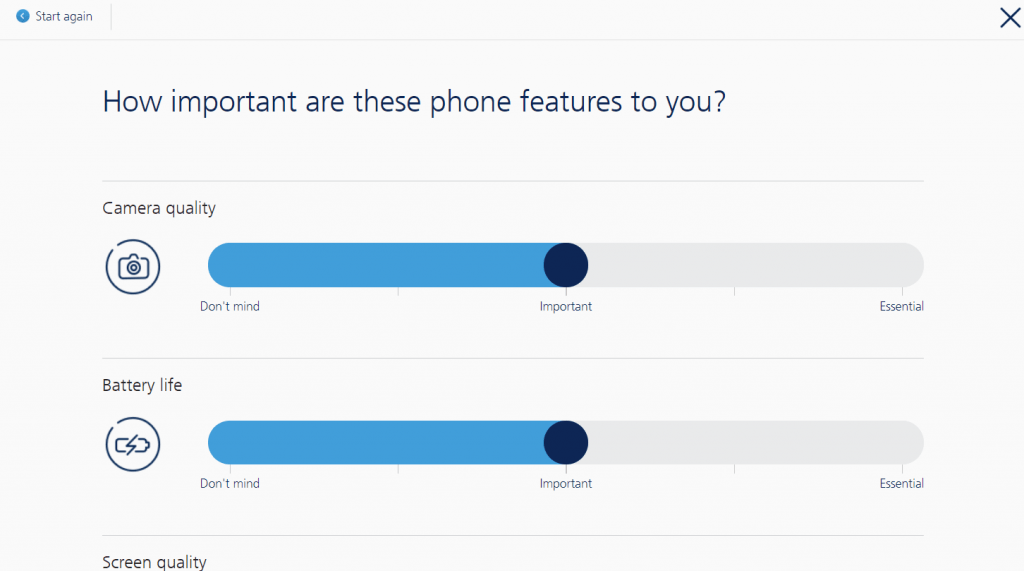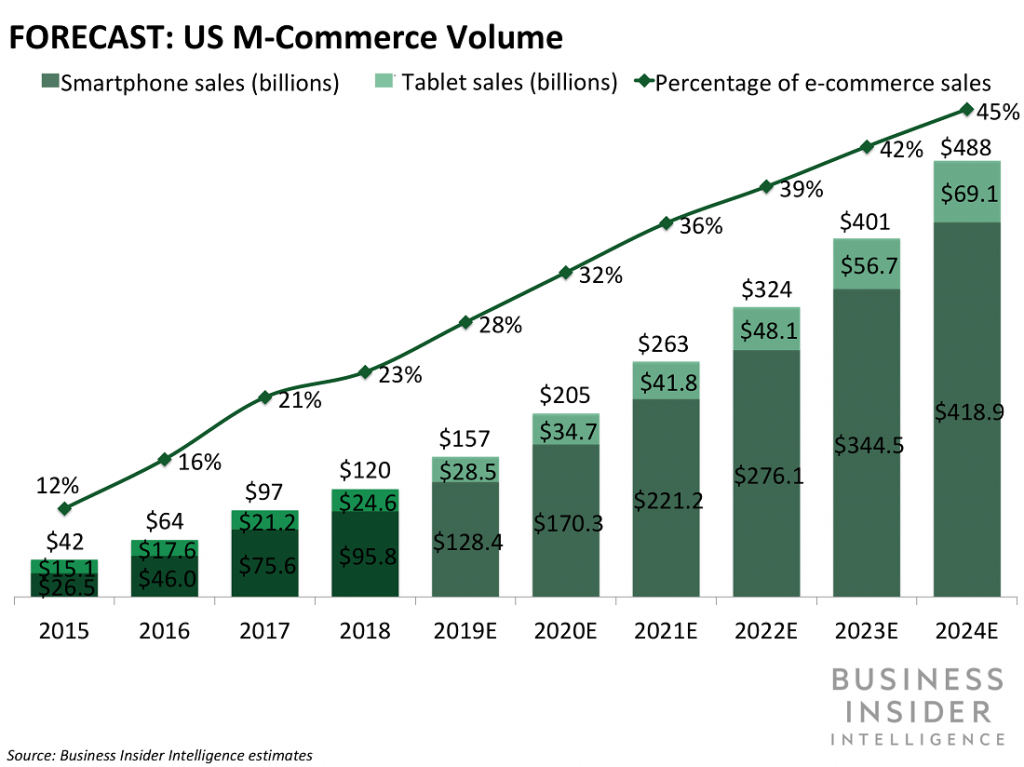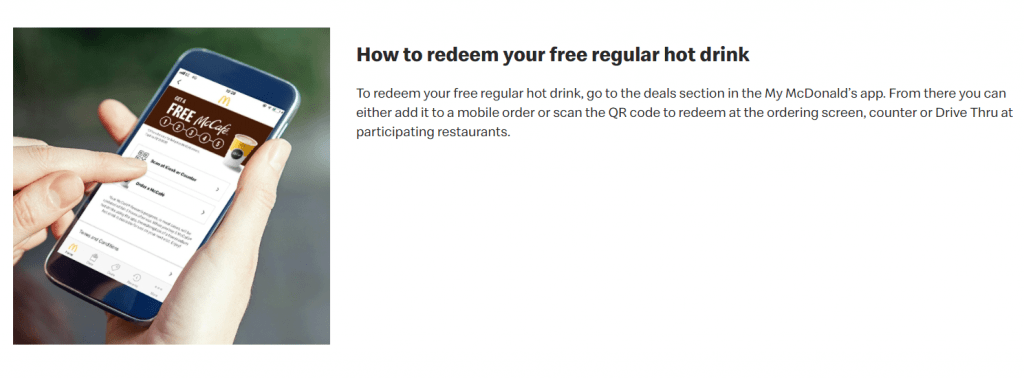If you’re running a business, you can no longer ignore the internet. Sure, brick-and-mortar stores are great. But if you want to succeed, you need to use the internet to your advantage, too.
According to Statista, the global eCommerce market is set to grow to $6,388 billion in 2024.
Opening up an online store is not enough, though. You need to implement robust eCommerce growth strategies to ensure the business develops and is able to compete in your niche.
So, where to start?
In this post, we give you nine top eCommerce growth hacks to test to grow your business.
How to Grow Your eCommerce Business
1. Improve Customer Retention
There’s little point in gaining customers if you can’t retain them. According to Annex Cloud, 65% of businesses’ customers are repeat customers. Repeat customers also spend 33% more on average per order.
That’s not surprising. You’re likely to purchase more products from a company you’ve used before that provided a great user experience. It’s part of the reason Amazon is so big.
[Source: LinkedIn]
Another reason to focus on your existing customers is that acquisition is expensive. It’s harder to convince a lead to purchase your product or service than convince a customer to make another purchase.
So, how exactly can you retain your customers?
Well, the solutions are many and varied. Fundamentally, though it comes down to three things:
- Good quality product, and delivering that product fast – or at least as fast as most of the other businesses in your sector.
- Excellent customer service for people who face problems. Review customer feedback and complaints. Quickly solve popular customer pain points, too. Remember, the customer knows best. So be informed by the customer’s opinion when making decisions.
- Loyalty programs and incentives targeting users at different touchpoints in their shopping journeys.
A great example of a successful customer loyalty program is the My Starbucks Reward program.
Here, customers pay for drinks with the app and can collect rewards to get free Starbucks products. So, why would their customers switch to the competition?
[Source: Media]
2. Optimize On-Site Experience
Optimizing your on-site experience is an effective eCommerce growth strategy.
To create a satisfying customer experience, you first need to analyze how customers use your eCommerce website. You need to know how long customers spend on the site, when they leave, and which pages they use. For this, you can use Google Analytics, heatmaps, and CRO solutions.
These insights can then be used to improve site structure and how content is linked together. That’s important because optimizing user flow is essential for a great on-site experience, too.
An example of a brand with a great on-site experience is Apple.
[Source: Apple]
Apple’s website has a great modern design, and the site structure makes the content flow nicely.
However, it’s not enough for you to just have a great design and a great on-site experience. Your site needs to be conducive to profit, too. Here are just some of the ways you can optimize on-site experience:
- See if your pages are loading quickly. If they aren’t, then it might be time to look for another web host.
- Ensure your website is optimized for search engines. There’s no point in having a great-looking website if it can’t be easily found with a search engine in the first place. Improving your search rankings requires a significant investment of resources. You’ll need to optimize your on-site content, do things like guest posting to increase your reach, and more.
- Pay attention to your cart abandonment rate. If it’s too high, then make adjustments to your site. There are many reasons people abandon their carts. Maybe you need to optimize the design of your payment page. Don’t forget to send your website visitors an email reminder about the item they were about to purchase in cases of cart abandonment. It could look something like this:
[Source: Hubspot]
Make sure you leave a clear call to action in the email that links to your website.
Use customer support tools like chatbots and live chat solutions. For example, you can try Tidio – an all-around customer communication tool with plenty of customizable features to tailor it to your audience. Delivering exceptional customer support with the help of advanced tools is a sure way to improve any eCommerce store experience.
3. Invest in Disruptive Technology
The way brands interact with customers is forever changing. A technology that changes this interaction is what you call disruptive technology. It is a technology that literally disrupts the way brands interact with customers, so much so that it replaces tools that brands have traditionally used for those interactions.
You don’t need to look any further for an example. TikTok, for instance, is a disruptive technology. It allows brands to interface with customers in a completely different way – through short, looped videos.
Early adopters of disruptive technology can see insane profits. That’s because you can get in on the ground floor of a fast-expanding market. You’d be a pioneer in their use, so to speak. How does that relate to your eCommerce business’ growth? Well, people love it when their brands are a pioneer of something. According to Quirks, 84% of consumers believe the company they purchase from should be innovative. It is a vital consumer selling point.
Just look at how Chipotle is reaping the benefits of being among the first brands to use TikTok.
[Source: Shorty Awards]
Instead of focusing on sales and leads on the platform, Chipotle used TikTok to improve its brand image. It utilized funny memes and music to highlight menu items. This is a great use of the TikTok platform, which is popular among younger people.
The result? Chipotle managed to create a fun, youthful image that struck a chord with members of that segment who continue to support the brand.
The key is identifying a disruptive technology early, then working out what content will perform well.
4. Test Virtual Assistants
Virtual shopping assistants are great for eCommerce growth. But what is a virtual shopping assistant? Well, it’s software that helps you search for products. It can also offer personalized recommendations (remember our previous discussion on how to use data to target your audience?).
So, what are the upsides?
First, virtual assistants reduce operating costs – by 78%, according to Virtudesk. They do this by reducing the number of queries reaching human customer service agents. When there are fewer queries to be answered by humans, the company doesn’t need to hire as many people.
Besides, virtual assistants can work 24/7. That means you can massively increase your chances of making a sale. Just think about it. When a visitor has a query at three in the morning, and a virtual assistant is there to answer, that visitor might just make that purchase then and there.
O2 is a great example of a company that effectively utilizes virtual assistants.
[Source: O2]
The virtual assistant assists the customer in their phone selection. It asks detailed questions to give the best product recommendations for the customer.
Another example is IBM’s solution Watson, which can scan products on an eCommerce site’s database and serve up recommendations to the potential customer based on their given criteria.
5. Incorporate New Payment Methods
Just having debit or credit card options isn’t enough. There are so many payment options at a consumer’s disposal nowadays. If you stick to only one to two, you decrease your chances for conversions.
New payment options like cryptocurrencies, for instance, are in demand with customers. Some reports predict that the cryptocurrency market will grow from $1.6 billion in 2021 to $2.2 billion by 2026.
E-wallets are another method of payment customers want to see at the checkout.
An e-wallet (like PayPal and Apple Pay) is linked to a customer’s bank account. The linked funds can then be used for purchases. It’s fast and works well on mobile. Customers can also store multiple cards. E-wallets eliminate the need to input card information, so it’s no surprise they’re growing in popularity.
According to Finder, an estimated 150 million Americans have used a digital wallet at some point in their lives. A whopping 66% of those surveyed said they use an e-wallet because it’s a more convenient payment method.
There’s no hard and fast rule for how many payment options you should offer for an effective eCommerce growth strategy.
[Source: Takealot]
Takealot, a popular eCommerce brand in South Africa, for instance, has several payment options for website visitors. When someone wants to pay for a purchase using a specific payment method because it’s more convenient, they can do so without any problems. For the merchant, including many payment methods also helps reduce cart abandonment.
You want to try to incorporate as many relevant options as necessary for your specific target audience. Doing so could help expand your market reach to those who don’t trust conventional payment options. Here are some options:
- Bizum: Customers input their Bizum account PIN to pay. The Bizum account is linked to their bank accounts.
- Afterpay: Reebok and Pandora use this method. It’s a buy now, pay later solution. Customers pay two weeks after the purchase then make three more payments in two-week intervals.
- Klarna: Another buy now, pay later solution. Klarna pays the eCommerce site for a purchase. The customer then pays Klarna back.
- Dwolla: Unlike PayPal which relies on the credit card infrastructure, Dwolla has its own network that allows for instantaneous money transfers.
- BlueSnap: The Click to Pay feature allows customers to pay using their credit cards with just the click of a button. The method is supported by four major credit card payment processors in the US: American Express, Discover, Mastercard, and Visa.
6. Leverage m-Commerce
Globally, 67.2% of all eCommerce is done on mobile devices. By the end of 2021, this will rise to 72.9%. That means optimizing your m-commerce strategy is essential.
[Source: Business Insider]
But simply having a functional mobile site isn’t enough. To capitalize on rising m-commerce trends, you need to account for m-commerce specifics. The main things you need to account for are:
- Customer location
- Contactless payment options
- Digital products
- Mobile banking
- E-tickets
Although many of these can be set up in your Shopify store, others require the use of other tools so you can implement them. For example, you need location-based service software to determine the locations of your customers and serve up information about what you sell depending on what you find. You can get that software from wireless carriers such as AT&T and Esri, for instance. For e-ticketing, you can use tools such as Ticketleap.
These features help personalize and improve the mobile eCommerce experience. They allow you to capture a larger share of the growing m-commerce market.
That’s McDonald’s strategy. Through the McDonald’s app, customers can order their meals in advance and collect rewards. Those rewards can then be redeemed in any McDonald’s store.
[Source: McDonald]
The app makes sales convenient and encourages brand loyalty, which is great for sales growth.
How you use omnichannel marketing depends on your niche.
7. Implement Environmentally Friendly Business Activities
Environmentally friendly businesses are in. More than 60% of millennials say they’d like to switch to a more environmentally friendly brand, according to ETC2.
Sustainable products are also a rapidly growing market. According to a study, 54% of the CPG market growth between 2015-2019 came from sustainable products.
[Source: NYU Stern]
Many brands are already adopting this strategy. Outdoor clothing chain Patagonia is an example.
Patagonia did not always have a stellar record with environmentalists. In 2015, Greenpeace criticized it after toxic chemicals were supposedly found in some of its products.
Nowadays, though, the eCommerce and retail brand has found ways to do better.
The company has released ads encouraging people not to buy products they don’t need (including their own). The ads also urged consumers to have their broken products repaired instead of throwing them away.
[Source: Ewha]
You don’t have to move mountains to become more sustainable as part of your eCommerce growth strategy. Small steps like responsible sourcing, recycling, and giveback programs, among others, can do wonders for your brand image. More importantly, it’s the right thing to do.
8.Utilizing the Power of AR
As great as eCommerce is, it has one major disadvantage compared to traditional retail: you can’t try the products. But with the emergence of AR, things are beginning to change.
Augmented reality allows customers to ‘see’ the product on themselves or in their homes. That way, they can experience the products even if they don’t actually have them and, hopefully, buy them.
GAP’s AR app is a great example. It allows customers to virtually try on clothes. Customers can see exactly whether or not a dress is too small or too big for them.
[Source: Designhubz]
AR technology hasn’t been widely adopted yet. But according to Vxchnge, the combined install base of AR tech could reach 2.5 billion units by this year. The AI market is even set to expand at a compound growth rate of 40.2% between 2021 and 2028, according to Grand View Research.
Incorporating augmented reality into your eCommerce store, however, isn’t that hard. Follow these steps:
- Identify your business objectives. Ask yourself, what do you want to achieve? What do you want the customer to experience? Is it the virtual try-on feature on your website or an interactive user manual?
- Determine the AR tools you’ll use. Once you know what your goal is, you can specify the tools you need. If you don’t have a big budget, start with an AR platform that offers a free licence (although don’t expect it to cater to all your customer needs). Make sure the platform you choose is compatible with every operating system you’d like the new technology to run on.
- Market your new technology. You can create a video that shows how the technology works and disseminate that across your marketing channels.
AR can help you stand out. Just make sure you test your technology before you deploy it so customers will really enjoy it and engage with your brand, without any interruptions.
9. Leverage PPC and Digital Marketing Automation
We all know you can’t grow your ecommerce business without marketing and advertising. After all, for people to go to your website, they need to know it exists in the first place. If you just sit and wait for website visitors, you’ll only waste your time and be disappointed at the results (or lack thereof).
Besides, there are many online platforms you can leverage for your marketing campaigns.
Social media, for instance, is a powerful tool that allows you to reach your target audience. According to Marketing Dive, 90% of consumers buy from brands they follow on social media.
Over 70% also purchased a product they saw on a social media post, according to Retail Touchpoints. In other words, if you’re not on any social media platform, you’re missing out.
According to Statista, a whopping 49% of consumers aged 18–29 said they purchased a product after viewing an ad for it on social media. Additionally, more than 41% of all clicks go to the top three paid ads on search results pages. In other words, more leads for you.
The secret to continued eCommerce growth and staying competitive with PPC and digital marketing however, is PPC automation.
This means investing in good PPC management software and service to create, run, manage, and optimize your campaigns to continuously bring the most conversions for your spend. Here are some eCommerce marketing strategy guides to help you grow your business:
If you are on the hunt for the best PPC management software for your store, check out this Best Alternatives to WordStream guide.
Wrapping Up
For an effective eCommerce growth strategy , you need to stay on top of the latest trends. An effective eCommerce growth strategy also needs to be multifaceted.
In this article, we shared some top tips you can try, including:
- Incorporating AR into your business mode
- Testing virtual assistants and investing in disruptive technology
- Using data to create personalized experiences, and improve the on-site experience
And don’t forget to implement ways to retain your existing customers!
Implementing all or a combination of these tips is optimal for an effective eCommerce growth strategy. Do that, and you’ll always stay ahead of the competition.

Jimmy Rodriguez is the VP of eCommerce at Shift4Shop, a completely free, enterprise-grade eCommerce solution. He's dedicated to helping internet retailers succeed online by developing digital marketing strategies and optimized shopping experiences that drive conversions and improve business performance.
Recommended articles
 Facebook Ads for eCommerce: 16 Strategies, Examples & Tips
Facebook Ads for eCommerce: 16 Strategies, Examples & Tips
 How to Build a Winning eCommerce Ads Strategy
How to Build a Winning eCommerce Ads Strategy
 Google Ads for eCommerce: Everything You Need to Know
Google Ads for eCommerce: Everything You Need to Know
 10X Your Traffic with PPC Management Software
10X Your Traffic with PPC Management Software
Comments
Powered by Facebook Comments
